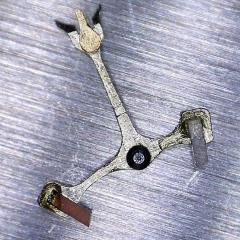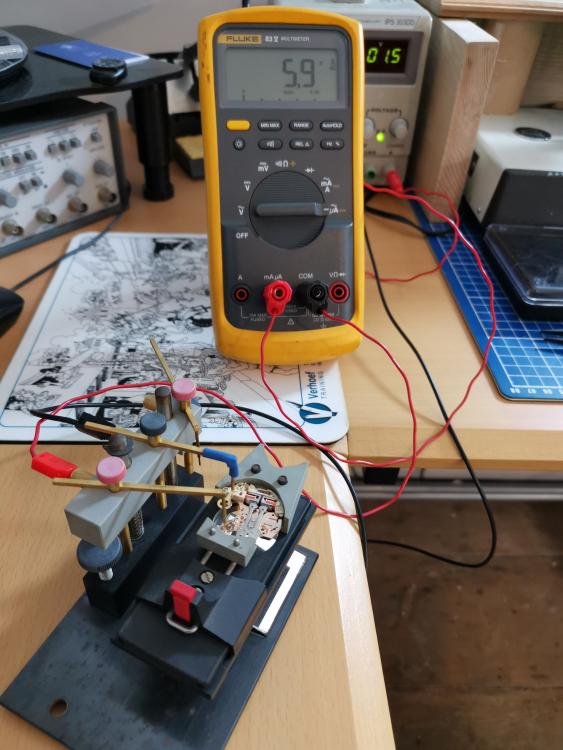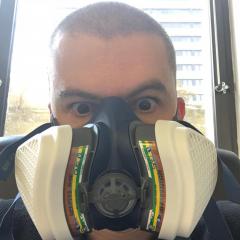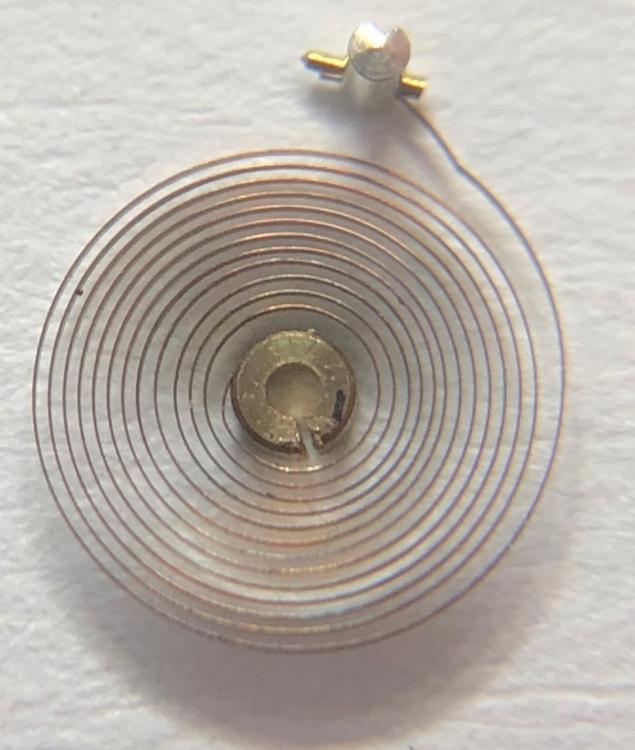Leaderboard
Popular Content
Showing content with the highest reputation on 12/30/21 in Posts
-
To give you a better idea of the company I have a link. Look what they were into in the 30s watch stuff and then what did they make in 1933 in? https://www.portescap.com/en/about-portescap/about-us1 point
-
1 point
-
You understood the issues very well, and noise level is the key. All software TMs do that already by a hold-off time, but it will not avoid noise, which averages to some constant permanent level. I don't know how other program developers handled it. My PCTM in auto mode uses the lowest possible threshold, i.e. just a bit over noise level. That is a very luxurious demand, Guido Frank1 point
-
That is a Westminster chime with strike normal duration 8 days. I would say its German I was hoping to see some sort of I D on the back plate but nothing. What is on the dial if anything. I have just found this set they are new. http://www.m-p.co.uk/muk/parts/chap03/cast-iron-gongs,-8-vertical-0904845015.htm You will need to log into this site to get all the details of sizes I suggest you phone them and see what they have. I would say this is the best place. https://www.cousinsuk.com/category/gongs-hammerback1 point
-
@Rhobin I did actually! I think there are upsides and downsides. Upsides, great reference materials and a lot of ground covered. Practical exercises very useful to build basic shop skills that I have never developed. Downsides, I find it definitely too clock focused. The watch material is oriented toward quartz (fair enough if you're gonna do this for a living), which is not really my speed. The mechanical watch material I really already know and I wish it would go into more depth there. So to cut a long story short, I have read everything and attempted a couple exercises. The problem is I keep getting distracted by servicing mechanical watches, which is not covered by the course. I don't regret purchasing it because I do want to do clocks some day soon, but it's a question of money and space right now (mainspring winder is just the start...). If I go for a certification, I think it is likely that I will do the CW21 since I am in Canada. Just my thoughts. Others' experiences will differ I'm sure. Feel free to PM me if you want to talk more about it!1 point
-
Hi I read a lot of people asking about microscope to work or inspect parts. To help people decide and make their own decision I'll provide here some pictures from it. This is the model I brought. My personal opinion is that it's really very helpful because you have really a great working distance almost 20 cm with good resolution of course if you bring closer the optics you can have higher Magnification. I've chosen to go for X100 because it's more than enough for watchmaking (I'm not a biologist So if you've any question you're welcomed1 point
-
@JohnC did you sign up for the BHI DLC? Looks like I'm in a similar place you were in. It would be good to hear of your experiences if you did. Thanks1 point
-
Thanks for this. Taboo as the subject is, I am inching toward a frankenwatch project involving a 2nd hand 2836-2 movement. I acquired a NOS case and dial of a Helvetia President watch. The hands are pretty standard fare. The 2836-2 and cousins seem to be dimensionally compatible with the case and i can design and 3d print my own spacer if needed, and the 2836-2 is superior to the original movement so as frankenwatches go, considering i rarely sell anything and would never sell this project without extensive documentation, i figure it is not too egregious. The 2836-2 bears dial and hands and rotor from a Wenger ("Swiss Military") watch and my timegrapher confirms that it is a 28800bph movement and running strong so i have doubts that it could be fake. It is certainly a loose movement that is at least 5 years old so some service is in order. I have 9010, D5, and 9415. I will probably use Nye PML Stem Grease on the winding components because i have it and it is excellent. I have 8302 natural grease with disulfide and i am under the impression that it is an acceptable braking grease if not as ideal as a couple other moebius products. Remains to be seen if i can be talked into Lubeta v105 as well. It could happen. It could also happen that i might just put on the 10x loupe and put a dab of something on several spots of the reversing wheels. I'll read through this at least a couple more times before i dive in.1 point
-
No kidding, I was at my parents' house two days ago, and we were sitting around the table talking. Probably over a meal. Somehow, a Richard Cheese cover of a Disturbed song came up. We all got a laugh. Fast forward 36 hours or so, and then that pops up. I had to watch it. Stopped the Marcin Wasilewski album mid-song. 2yo is sitting here eating cheerios before going to grandparents' house for xmas, and she starts singing along (obviously doesn't know the words, but just musical noises to go with the tune). She stopped once Draiman really got going though. Seems she might be underexposed to more... energetic music. Once it was clearly over, I started to turn the laptop back around to type this. She wasn't done until the orchestra was.1 point
-
I think that the course is excellent in that it sets a high benchmark on how work should be done properly and also goes into a decent amount of depth in the theory. I did mine largely at home, but did do some of it at an accredited school. I think two years is a reasonable amount of time to cover it if you also have a full-time job. I think it's fair to say that it is fairly challenging. Many people who I started out with dropped out - especailly those who were not interested in learning the theory. A. For practical work, it was useful to be shown in person how to do things. Even something simple like someone saying that your vice is at the wrong height for filing flat. B. For the theory, not really. C. Yes. The exams force you to read get clued-up on the material. D. No problem. You'll just need a small lathe, decent vice, quality files, scriber, centre-punch, Sharpie pen, piercing saw and a full set of drill bits. E. I believe so. You could purchase older revisions of the material to learn and just sit the exams, but it's not easy to get a hold of. F. I can't really comment as I have not done Mark's course. Remember that the BHI course also includes clockmaking material which does cross over to watchmaking when it comes to making/adapting parts and making tools. It covers topics like metallurgy in good depth which a lot of people seem to be lacking in.1 point
-
It seems I accidentally won this pocket watch. i had my eye on this open balance pocket watch with a mother of pearl case back. I set up a bid snipe on my app for it and then a couple days later I removed it from my watch list because I changed my mind. However, I forgot about the snipe and a day later I got an alert that I had won. hopefully there is nothing broken on the inside. It's being sold as non running, fingers crossed it just needs a cleaning.The mother of pearl case back has a large chunk missing near the crown, not sure what I can do to repair that. I'll keep everyone in the loop as I go through it. It was cheap enough that if I get it running, I may repair the original with epoxy putty, make a mold of it and the cast a new one with a mother of pearl epoxy. May be a fun project.1 point
-
I just thought I'd share this as it may be useful for another learner. By far the most difficult thing I've come across starting out in watch repair has been correcting bends in hairsprings. I've got the right tools, the right light, a powerful eye glass and a pile of scrap watches I've been practicing on. But I found time after time I was just making the hairsprings worse. I think part of my problem is that I'm slightly dyslexic and I find looking at the spiral really confusing sometimes. But I had a bit of break through last weekend which has dramatically improved my technique. Quite simply, I hold my eye glass up to my iPhone lens and take a close up picture of the hair spring. I then make a cup of tea and sit and look at the photo, zoom right the way in and really think about what I'm going to do. This is so much more effective than hunching over the hairspring and straining my eyes for long periods and losing patience. Once I've really thought about what I'm going to do, I go back to the hairspring with a clear strategy, ie, slight bend in, fourth from the centre at 3 o'clock. I apply the bend, take another picture and repeat. I know it sounds simple, but it's been a huge help to me and I'm finally having success1 point








.thumb.jpg.62c9597ea416456873d23c486308f3a9.jpg)
.thumb.jpg.4f263f09121092e489b8efe7553b3bc3.jpg)

